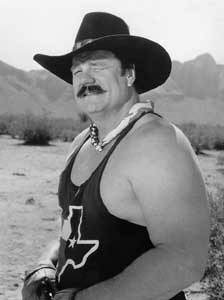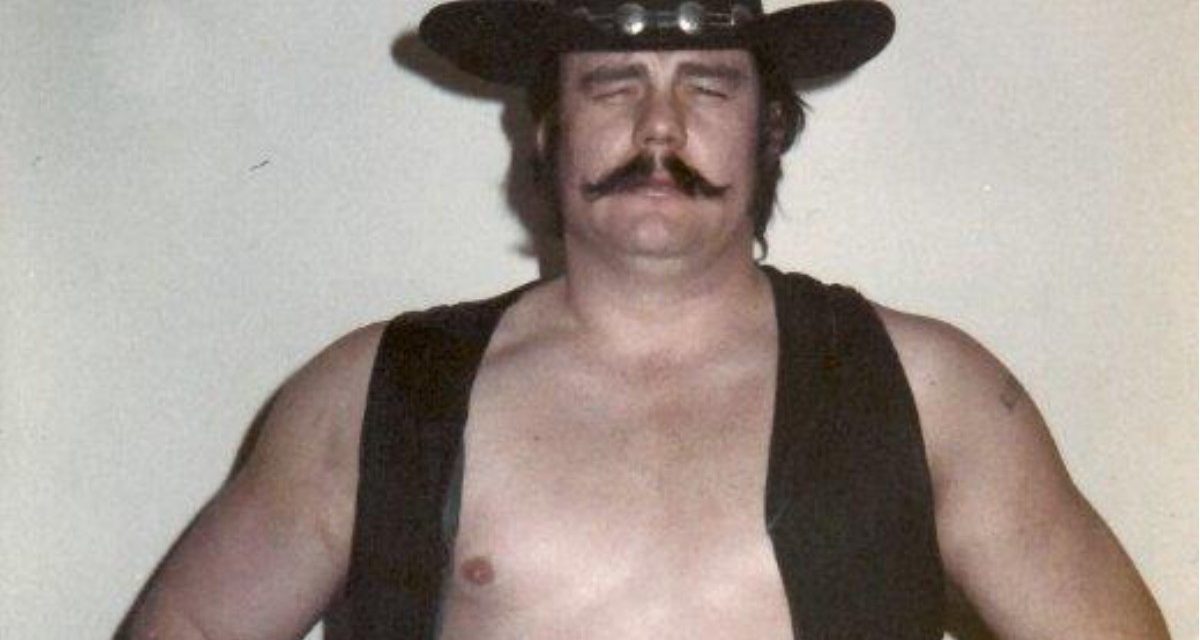Bobby Jack Windham is 59 now and hasn’t competed in the ring as Blackjack Mulligan for almost a decade now. But get him into the water, and it’s a different story.
You see, Blackjack’s a deep-sea diver.

Blackjack Mulligan in his WWF days in 1986.
“Really, it’s the perfect thing for me to do because I hurt a lot. When I get in the water, I’m weightless and that’s when I feel at one with my body again,” Mulligan told SLAM! Wrestling. “I can’t compete anymore because of the injuries, massive injuries, knees, this, that. Once I get in the water, it’s perfect. I love it. I’m equal again. Blackjack’s back!”
He was a U.S. Marine in Guam in 1960 when he first got experience at diving, heading out with some buddies on the underwater demolition team. Thirty years later, one thing led to another, and he was diving off the coast of Florida, and Mulligan has a wreck-diving certificate, a deep diving certificate, and dives into caves. It’s enough that he wishes that he studied geology and anthropology at West Texas State rather than education and football.
“Back in those days, there was no certification so I started then and there I was so busy for 30 years, I got back into it a few years ago because I couldn’t run anymore, I couldn’t do the physical bicycling that I wanted to do so I said I’ve got to find me an alternate exercise,” he explained.
But get Mulligan talking about pro wrestling or his kids and he’s 10 years younger in an instant.
The 6-foot-9, 345-pound Mulligan from Sweetwater, Texas, was a promising football player at West Texas State and got into the New York Jets organization. Things didn’t go exactly according to plan there, and he broke his leg. Sonny Werblin was the head of the syndicate that owned the Jets at the time, and was also CEO of the Madison Square Gardens Corp., where the WWWF held shows, and he suggested the future Blackjack should try wrestling.
“If I’d been a horse, they’d have shot me as far as football was concerned,” he recalled. “They farmed me out to the Dakota badlands [for] two years training and out of there came Jack Mulligan, doing all the ‘Villes, the ‘Burgs, and the Winnipegs. You know how it is out there — a cold, desert land. Two years later, Jack Mulligan emerged to main event.”
Wrestling was hardly a new concept to him. “I was raised around a family out in West Texas, the Funks. That’s how I originally got the bug myself being a football player. Dory Funk Sr., being around Dory, Terry. I was from a little town called Sweetwater, Texas and Dory and Terry were all up from Amarillo.”
Dressed in black — cowboy boots, hat, trunks — Blackjack Mulligan looked mean and could back it up. His dreaded clawhold, featuring his gloved hand, struck fear both into opponents and fans alike.
In August 1975, he teamed with Blackjack Lanza to beat Dominic Denucci and Pat Barrett for the WWWF World Tag Team titles, losing them a short time later to the Canadian team of Tony Parisi and Louis Cerdan (who later was Gino Brito).
The late ’70s saw Mulligan as a headliner in the Mid-Atlantic territory. He won the NWA World Tag Team titles with Ric Flair in 1979, winning them from, and losing them back to Baron Von Raschke and Paul Jones.
During the same era, he also worked with the late Dick Murdoch to promote the Amarillo, Texas territory.
In 1981, he won a ‘world’ title of sorts, capturing the World Wrestling Association’s top belt from the late Bobo Brazil.
Some of his greatest feuds came against the likes of Big John Studd, Angelo ‘King Kong’ Mosca, Masked Superstar, Dory Funk Jr., and Kevin Sullivan’s satanic stable.
Perhaps Mulligan is not given the credit he deserves for changing the business in the 1970s. He was an innovative and exciting interview. “When Dusty [Rhodes] and I came in the business, it was like ‘Oh you guys are ruining the business with your TV rap’. Myself, Dusty and [Superstar] Billy Graham, we revolutionized the business by doing what they call soul rap interview, getting the people into the buildings with our talk. But we could back it up with our performances.”
With his distinct Texan drawl, Mulligan has a 1001 stories to tell about his days in pro wrestling.
One time, CBS’s Charles Kuralt was doing an On The Road segment with Mulligan and Wahoo McDaniel. “It was a tremendous wrap-up, and at the end [Kuralt] just had to say, had to get his shot in, ‘Well, there they were, Wahoo and Jack smothered with chicken blood.’ Boom! And he didn’t believe. Well, we beat each other to death on the four, five shows we did for Kuralt. It was no chicken blood. It was our blood. So we took it a little personal because we were jocks and athletes.”
Coming from a tradition football-wrestling powerhouse school like West Texas State, where stars like the Funks, Dusty Rhodes, and Ted Dibiase all went, Mulligan isn’t high on today’s wrestling. The training that one got from the likes of Terry and Dory Funk Jr., Jack and Jerry Brisco or Stu Hart just doesn’t exist anymore. “You went in the grinder. They talk about the basement of Stu Hart. That was a tattoo that you got. That was a learning deal that you went through that nobody ever went through. If you made it through Stu Hart’s school of learning up there and came out of that thing, you were known to be a product, a quality product because there were certain levels you had to do to be associated with Stu Hart and the Funks and the Gene Kiniskis and the Don Leo Jonathans. Giants of this business. There’s just no human beings around like those people anymore. They were my idols, and they always will be.”
On more than one occasion during his conversation with SLAM! Wrestling, Mulligan raved about Don Leo Jonathan , the Mormon giant. “I was always trying to measure up to Don Leo Jonathon. Never made it.” Yet, like Jonathon, Mulligan too became a deep-sea diver.
Working for Paul and Maurice Vachon with Grand Prix Wrestling in Montreal in the 1970s was another highlight for Mulligan. “It was just a great experience for me. I got to meet so many of the old guys,” he said, naming names like Edouard Carpentier, Killer Kowalksi, and, of course, Jonathon.
The ’80s saw Mulligan give way to the next generation of stars from his family.
Barry Windham was his oldest son, and became a huge star. “I’ve never seen a kid … born with more talent,” Mulligan said. “He had the speed that I didn’t have … He was so great that he goofed off a lot. He had so much talent, so much talent. It’s unbelievable Everything I did, he just eclipsed it, for sure.”
Kendall, ten years Barry’s junior, was a different story. “Kendall wasn’t gifted with the talent that Barry had, physical big size. He probably was an overachiever. Two different people entirely.”
Mulligan’s daughter married Mike Rotunda.
The last big hurrah for Mulligan came in the WWF of 1986 and 1987. He competed as himself for a while and was a solid mid-carder. Later, he became Big Machine in the tag team trio along with Andre the Giant (Giant Machine) and Super Machine (Bill Eadie, aka Masked Superstar, Demolition Axe). But Mulligan was never completely comfortable with Vince McMahon Jr’s ideas for pro wrestling.
“We’re in New York in the early days, when Vince started having some problems, maybe 12 years ago,” Mulligan said, starting into another story. “There were some morality problems there, I mean serious, that we didn’t like. I said to him, ‘Vince, you’re getting campy with this show, where you going with this show?’ And we’re driving to Tuscon, Arizona. I had him trapped in the car with me — he didn’t like being trapped anywhere he couldn’t escape out of real quick. He said, ‘Look, you worked for the old man. (Vince McMahon Sr.) If you don’t change, you’re just going to blow away to dust.’ I said, ‘Excuse me? If I don’t change, I will not exist?’ He said, ‘The bigger fool you make me make of you, the more money I will make you.’
Mulligan did kind of fade out of the WWF after his run ended in the late ’80s, but he hasn’t turned to dust. He’s not happy with the way that pro wrestling has changed. “We just kind of turn over in our proverbial graves when we watch this. We don’t even watch it. When somebody asks me now to defend the credibility of the business, it’s impossible. There is none.”
RELATED LINK

